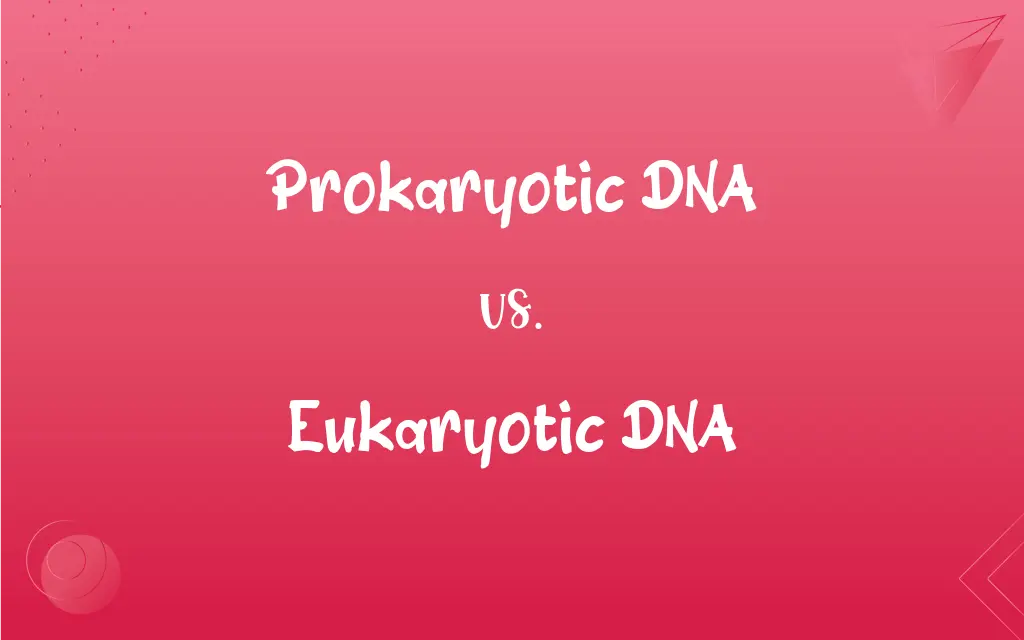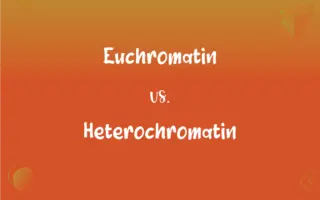Prokaryotic DNA vs. Eukaryotic DNA: What's the Difference?
Edited by Aimie Carlson || By Harlon Moss || Updated on October 30, 2023
Prokaryotic DNA is circular, lacks a membrane-bound nucleus, and is found in prokaryotes; eukaryotic DNA is linear, enclosed in a nucleus, and found in eukaryotes.

Key Differences
Prokaryotic DNA is found in bacteria and archaea, simpler single-celled organisms without a nucleus. Eukaryotic DNA is found in plants, animals, and fungi, all of which are more complex, multi-cellular organisms with a nucleus. The difference in DNA reflects the complexity of the organism.
The replication of prokaryotic DNA is simpler and faster than that of eukaryotic DNA. In prokaryotes, DNA replication is often initiated at a single point and proceeds bidirectionally until the entire chromosome is copied. In eukaryotes, DNA replication is initiated at many points along the chromosome, making the process more complex and slower.
Prokaryotic DNA is less prone to mutations than eukaryotic DNA due to its simpler structure and fewer regulatory mechanisms. This simplicity allows for faster adaptation to changing environments but also means that prokaryotes lack the same level of control over their DNA that eukaryotes possess. This is a crucial distinction that impacts the evolution and behavior of these two groups of organisms.
Comparison Chart
Structure
Circular
Linear
Location
Cytoplasm, no nucleus
Membrane-bound nucleus
ADVERTISEMENT
Complexity
Simple
Complex
Organism Type
Bacteria, archaea (single-celled)
Plants, animals, fungi (multi-cellular)
Replication Speed
Faster
Slower
Prokaryotic DNA and Eukaryotic DNA Definitions
Prokaryotic DNA
Prokaryotic DNA is genetic material found in bacteria and archaea.
The antibiotic resistance gene is often located on the prokaryotic DNA of bacteria.
Eukaryotic DNA
Eukaryotic DNA is genetic material found in plants, animals, and fungi.
Human DNA is a form of eukaryotic DNA.
ADVERTISEMENT
Prokaryotic DNA
Prokaryotic DNA is not enclosed in a nucleus.
The lack of a nucleus allows for easier access to the prokaryotic DNA for transcription and translation.
Eukaryotic DNA
Eukaryotic DNA is enclosed in a nucleus.
The nucleus protects the eukaryotic DNA from damage during cellular processes.
Prokaryotic DNA
Prokaryotic DNA floats freely in the cell's cytoplasm.
The cytoplasm of a bacterial cell is filled with its prokaryotic DNA.
Eukaryotic DNA
Eukaryotic DNA is housed within a membrane-bound nucleus.
The nucleus is an essential component of eukaryotic cells.
Prokaryotic DNA
Prokaryotic DNA is simple and circular.
Prokaryotic DNA can replicate faster than eukaryotic DNA due to its simple structure.
Eukaryotic DNA
Eukaryotic DNA contains many regulatory elements.
These regulatory elements help control the expression of genes in eukaryotic organisms.
Prokaryotic DNA
Prokaryotic DNA contains fewer regulatory elements than eukaryotic DNA.
This lack of regulation can lead to faster evolution in prokaryotic organisms.
Eukaryotic DNA
Eukaryotic DNA is complex and linear.
The complexity of eukaryotic DNA allows for more information to be stored.
FAQs
Where is eukaryotic DNA located?
Eukaryotic DNA is located within a membrane-bound nucleus.
How does prokaryotic DNA contribute to evolution?
Prokaryotic DNA allows for faster adaptation to changing environments, contributing to evolution.
What is the role of the nucleus in eukaryotic DNA?
The nucleus protects the eukaryotic DNA and helps regulate gene expression.
How do regulatory elements impact eukaryotic DNA?
Regulatory elements in eukaryotic DNA control the expression of genes, ensuring the proper functioning of the organism.
How does prokaryotic DNA contribute to the behavior of prokaryotic organisms?
Prokaryotic DNA contributes to the behavior of prokaryotic organisms by allowing for faster adaptation to environmental changes.
How is prokaryotic DNA different from eukaryotic DNA?
Prokaryotic DNA is simple, circular, and not enclosed in a nucleus; eukaryotic DNA is complex, linear, and enclosed in a nucleus.
What are the regulatory elements in eukaryotic DNA?
Regulatory elements in eukaryotic DNA help control gene expression.
Where is prokaryotic DNA located?
Prokaryotic DNA is located in the cell's cytoplasm.
How is eukaryotic DNA replicated?
Eukaryotic DNA is replicated in a more complex manner with many points of initiation.
How does the structure of prokaryotic DNA impact replication?
The simple, circular structure of prokaryotic DNA allows for faster replication.
How does the structure of eukaryotic DNA impact replication?
The complex, linear structure of eukaryotic DNA makes replication a slower and more complex process.
What is the importance of the membrane-bound nucleus in eukaryotic cells?
The membrane-bound nucleus is an essential component that protects eukaryotic DNA and helps regulate cellular processes.
What is prokaryotic DNA?
Prokaryotic DNA is the genetic material found in bacteria and archaea.
What is eukaryotic DNA?
Eukaryotic DNA is the genetic material found in plants, animals, and fungi.
How is prokaryotic DNA replicated?
Prokaryotic DNA is replicated in a simpler and faster manner than eukaryotic DNA.
How does prokaryotic DNA differ from eukaryotic DNA in terms of complexity?
Prokaryotic DNA is less complex than eukaryotic DNA, reflecting the simplicity of the organisms they are found in.
Why is prokaryotic DNA less prone to mutations?
Prokaryotic DNA is less prone to mutations due to its simpler structure and fewer regulatory mechanisms.
What types of organisms have prokaryotic DNA?
Prokaryotic DNA is found in bacteria and archaea.
What types of organisms have eukaryotic DNA?
Eukaryotic DNA is found in plants, animals, and fungi.
How does eukaryotic DNA impact gene expression?
The regulatory elements in eukaryotic DNA play a crucial role in controlling gene expression.
About Author
Written by
Harlon MossHarlon is a seasoned quality moderator and accomplished content writer for Difference Wiki. An alumnus of the prestigious University of California, he earned his degree in Computer Science. Leveraging his academic background, Harlon brings a meticulous and informed perspective to his work, ensuring content accuracy and excellence.
Edited by
Aimie CarlsonAimie Carlson, holding a master's degree in English literature, is a fervent English language enthusiast. She lends her writing talents to Difference Wiki, a prominent website that specializes in comparisons, offering readers insightful analyses that both captivate and inform.































































